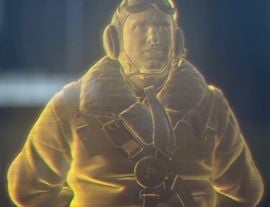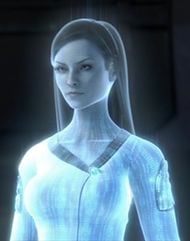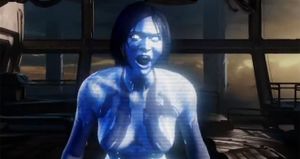Smart AI: Difference between revisions
From Halopedia, the Halo wiki
Sith Venator (talk | contribs) (I knew not watching that hour and a half video would bite me in the butt.) |
NightHammer (talk | contribs) |
||
| Line 40: | Line 40: | ||
*[[Araqiel]] - Colonel Ackerson's personal AI | *[[Araqiel]] - Colonel Ackerson's personal AI | ||
*[[Cortana]] - CTN 0452-9 - UNSC military AI<ref group="note">Cortana is mentioned in Dr. Halsey's personal journal (May 21, 2549) as being a 3rd-generation smart AI. It is curious that Halsey would use the supposedly obsolete third-generation architecture to create her state-of-the-art AI when the ''fifth'' generation had already been active for years. Since the nature of the generational classification system is not elaborated upon, it is possible that the upgrades relate to other aspects of the AI's software architecture ([[Deep Winter#Notes|e.g. its lifespan]]) than the ones relevant for Cortana's primary mission of software intrusion, and that the third generation may even have been superior to the later ones in this regard.</ref> | *[[Cortana]] - CTN 0452-9 - UNSC military AI<ref group="note">Cortana is mentioned in Dr. Halsey's personal journal (May 21, 2549) as being a 3rd-generation smart AI. It is curious that Halsey would use the supposedly obsolete third-generation architecture to create her state-of-the-art AI when the ''fifth'' generation had already been active for years. Since the nature of the generational classification system is not elaborated upon, it is possible that the upgrades relate to other aspects of the AI's software architecture ([[Deep Winter#Notes|e.g. its lifespan]]) than the ones relevant for Cortana's primary mission of software intrusion, and that the third generation may even have been superior to the later ones in this regard.</ref> | ||
*[[Iona]] - AI attached to SPARTAN [[Black Team]]. | |||
===Fourth Generation=== | ===Fourth Generation=== | ||
| Line 51: | Line 52: | ||
*[[Chauncey]] - {{UNSCShip|Red Horse}}'s old smart AI | *[[Chauncey]] - {{UNSCShip|Red Horse}}'s old smart AI | ||
*[[Eternal Spring]] - First known overseer of UNSC facilities on planet Onyx, aided in reconnaissance of Zone 67. | *[[Eternal Spring]] - First known overseer of UNSC facilities on planet Onyx, aided in reconnaissance of Zone 67. | ||
*[[Juliana]] - Commercial AI operating in [[Madrigal]], unpacked after the planet's destruction by the Covenant to control [[the Rubble]]'s guidance and maneuvering. | *[[Juliana]] - Commercial AI operating in [[Madrigal]], unpacked after the planet's destruction by the Covenant to control [[the Rubble]]'s guidance and maneuvering. | ||
*[[Kalmiya]] - Dr. Halsey's former personal AI, Cortana's "older sister". | *[[Kalmiya]] - Dr. Halsey's former personal AI, Cortana's "older sister". | ||
Revision as of 18:50, September 11, 2015

- "Each of us represents a single trans-human mind. Each of us is an undrawn map – not a mere physical reconstruction of an object as it was in life – but full, human potential realized in crystal and thinking at the speed of light!"
- — One of the AIs of the Assembly
"Smart" AI is the colloquial term in the United Nations Space Command for artificial intelligence (AI) which have no limitations in their dynamic memory-processor matrix, meaning they can not only be taught a vast wealth of information, but can learn and comprehend from their surroundings. This is unlike "dumb" AIs who can only learn a limited set of topics and lack ingenuity.[1][2]
Background
The first smart AI was created in the mid-21st century. At first, there was great concern that this new technology would become too capable and render human intelligence obsolete. The ability for vocal expression was added to make smart AIs less threatening, allowing them to converse on the same level as their masters. Over time, such AIs became more advanced.[1] Due to their uninhibited matrix design, "smart" AIs proved capable of intellectual development. This is manifested in that they can actively learn from and adapt to situations and events. Conversely, their counterparts, the so-called "dumb" AIs, can not; while extremely competent in their designated tasks and fields of expertise, they are 'merely' highly-advanced computer programs and are not capable of intuition.[2] Like all AIs, smart AIs use a Riemann matrix for higher-function processing. This matrix, typically housed in the crystalline computing cluster of a data center,[3] can be downloaded into a data crystal chip for mobility. The Riemann matrix includes a secret fail-safe that can be used to destroy the AI in the event of rampancy or if there is a risk of the AI's data becoming compromised.[4]

Smart AIs are subject to Isaac Asimov's Three Laws of Robotics, a series of rules set up in order to prevent the AI from causing harm to humans or itself. Since many AIs are used for military purposes, they are capable of ignoring the First Law, but only when operating at full capacity; when their processing capabilities are diminished - say, by being cut off from the core of the ship or facility they are stationed on - they are incapable of bypassing the Law.[5]
As with "dumb" AIs, every "smart" AI represents itself through a self-assigned holographic avatar.[6] Avatars can range from the complex and theatrical, such as those of Araqiel and Deep Winter, to simpler human forms such as those of Melissa, Cortana and Serina. The appearance of an AI's avatar is sometimes derived from the physical traits of the person they are created from; for example, Cortana resembles a younger version of Dr. Halsey.
Dr. Catherine Halsey worked extensively with smart AIs and oversaw the construction of all their programming. She has an unparalleled knowledge on how AIs work and also created the upgrades for the MJOLNIR armor so it would be capable of carrying an AI. She and her team successfully managed to create a neural link between a human and a smart AI for the first time. Through a neural interface, the neural network of the AI and the low-order structure of the human brain would be effectively connected. This was first tested by John-117 and Cortana in August 29, 2552.[7] Dr. Halsey also had her brain flash cloned, which in turn were scanned to create the AI Cortana.[8] However, this was considered highly illegal and unethical.[9]
Despite the fact that "smart" AIs are essentially trans-human minds, they are treated as little more than tools, and their activities are closely monitored. Due to their superior intelligence, some "smart" AIs secretly consider themselves as the "next step" in human evolution. By 2310, a group of "smart" AIs had formed the Assembly, a collective that worked to preserve the human race, without humanity's knowledge. The group existed for centuries, and was ultimately behind many important events in human history.[10]
Creation
- Main article: Cognitive Impression Modeling
Instead of simply "programming" a smart AI, their matrix is created by scanning and replicating the neural pathways of a human brain.[11] This process destroys the original brain tissue, and so the brain being used is typically obtained after the host is dead.[12] This process is still inefficient, however, as neural linkages are "wasted" in the process of the budding AI generating its own system of more efficient neural linkages to replace those of the seed brain, in turn eroding the AI's limited lifespan.[9]
Because of the nature of this process the smart AI often retains residual thoughts, memories and/or feelings from the brain donor.[13] These residuals can be anything from the "feeling" of a hair brush being pulled through hair (in the case of Sif),[14] to an effect on the mannerisms and characteristics that make up the personality of an AI, in the case of Cortana and her likeness to Dr. Catherine Halsey as well as her possessing many of Halsey's memories, which surfaced during her descent into rampancy.[15]
Lifespan

- Main article: Rampancy
Another feature which stems from their unusual nature is a limited lifespan. Dr. Halsey compared the life cycle of a smart AI to that of a star: "they spark, burn brightly, and then either die by the crush of gravity or quickly terminate in a chaotic eruption".[9]
Unlike dumb AIs, smart AIs not only accumulate knowledge but also grow in their ability to draw conclusions from an incomplete dataset - similar to human intuition or creativity.[16] Over time, this causes them to form more and more cross-linkages within their processing matrix. This increases their cognitive abilities, but also shortens their operational lifespan; with such an excessive overload of data their function under normal parameters is no longer possible.[9]
The interconnections continue with two possible outcomes: the sheer density of linkages causes a cascade of irreversible quantum transfer (comparable to a short circuit), eventually halting all functions, or the AI may take corrective action and begins to pre-emptively sever neural linkages through a voltage overload. This often results in a condition known as rampancy, which is characterized by aberrant manifestations of personality.[9] This eventually leads to the AI eliminating more and more vital connections which in the end proves terminal, and essentially kills the AI system. An apt analogy to this would be a human brain devoting so much of its work towards thought that its neural signals to vital organs cease. In this way the AIs quite literally 'think' themselves to death.[17]
Currently, smart AIs have a lifespan of about seven years.[16] This trait was able to be forestalled in later generations of "smart" AI such as Deep Winter.[18] A number of solutions for a smart AI's short lifespan have been proposed, none of which are known to have been effectively implemented.
Known UNSC "smart" AIs
Third Generation
- Araqiel - Colonel Ackerson's personal AI
- Cortana - CTN 0452-9 - UNSC military AI[note 1]
- Iona - AI attached to SPARTAN Black Team.
Fourth Generation
- Black-Box - BBX 8995-1 - An ONI AI and assistant to Admiral Margaret Parangosky and Captain Serin Osman.
Fifth Generation
- Deep Winter - Overseer of UNSC facilities on planet Onyx, succeeding Eternal Spring.
- Endless Summer - MIL AI 4279 - Overseer of UNSC facilities on planet Onyx, succeeding Deep Winter.
Other/unknown
- Chauncey - UNSC Red Horse's old smart AI
- Eternal Spring - First known overseer of UNSC facilities on planet Onyx, aided in reconnaissance of Zone 67.
- Juliana - Commercial AI operating in Madrigal, unpacked after the planet's destruction by the Covenant to control the Rubble's guidance and maneuvering.
- Kalmiya - Dr. Halsey's former personal AI, Cortana's "older sister".
- Loki - Colony ship AI (military) of the UNSC Skidbladnir. Reassigned as PSI (Planetary Security Intelligence) on Harvest, second AI core on stand-by next to AI Mack.
- Lorelei - Ship AI of the Template:CMA ship
- Lysithea - UNSC/ONI AI, was located in the UNSC High Command's headquarters, HIGHCOM Facility Bravo-6 in Sydney, Australia.
- Mack - Colonial Administration Authority AI/Agricultural Operations.
- Melissa - UNSC/ONI AI, attached to UNSC Apocalypso.
- Mo Ye - Shipboard AI of the UNSC The Heart of Midlothian.
- Rebecca - UNSC Red Horse's smart AI
- Roland - RLD 0205-4 - UNSC AI, Shipboard AI of the UNSC Infinity as of 2558.
- Serina - SNA 1292-4 - UNSC AI, served aboard the UNSC Spirit of Fire.
- Sif - Colonial Authority AI/Shipping Operations.
Trivia
- Smart AIs' lifespans are about seven years long, this is another reference to Bungie's favorite number, seven.
- Some smart AIs have avoided rampancy or have at least not shown it, such as Juliana.
- Due to their imagination and limited lifespan, smart AIs are intrigued by existential philosophy, such as Zen koans.[19]
Gallery
List of appearances
Note
- ^ Cortana is mentioned in Dr. Halsey's personal journal (May 21, 2549) as being a 3rd-generation smart AI. It is curious that Halsey would use the supposedly obsolete third-generation architecture to create her state-of-the-art AI when the fifth generation had already been active for years. Since the nature of the generational classification system is not elaborated upon, it is possible that the upgrades relate to other aspects of the AI's software architecture (e.g. its lifespan) than the ones relevant for Cortana's primary mission of software intrusion, and that the third generation may even have been superior to the later ones in this regard.
Sources
- ^ a b Halo: Contact Harvest, page 30
- ^ a b Halo: The Fall of Reach, page 235
- ^ Halo: Contact Harvest, page 182
- ^ Halo: First Strike, page 128
- ^ Halo: Evolutions - Essential Tales of the Halo Universe, "Midnight in the Heart of Midlothian", page 88
- ^ Halo: Glasslands, page 111
- ^ Dr. Halsey's personal journal, March 24, 2549
- ^ Halo: The Fall of Reach, page 18
- ^ a b c d e Halo: Reach, Dr. Halsey's personal journal Cite error: Invalid
<ref>tag; name "journal" defined multiple times with different content - ^ Halo: Reach, Data pads
- ^ Halo: The Fall of Reach, pages 235-236
- ^ Dr. Halsey's personal journal, May 21, 2549
- ^ Halo Encyclopedia, page 229
- ^ Halo: Contact Harvest, page 33
- ^ Halo 4, campaign level Composer
- ^ a b Halo: First Strike, page 195
- ^ Halo: The Cole Protocol, page 86
- ^ Halo: Ghosts of Onyx, page 108
- ^ Halo: Ghosts of Onyx, page 178



